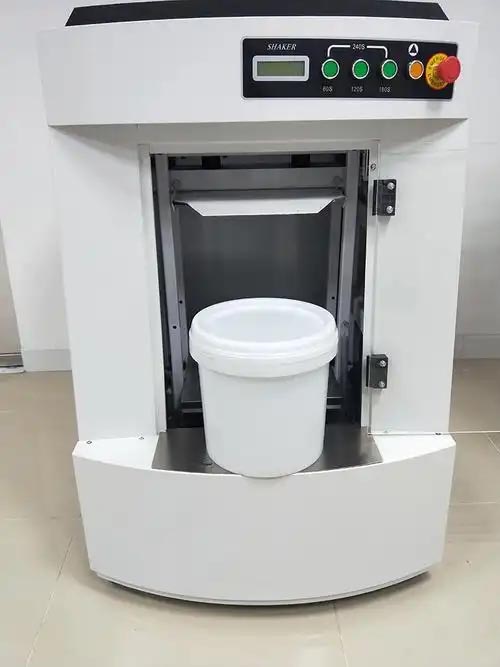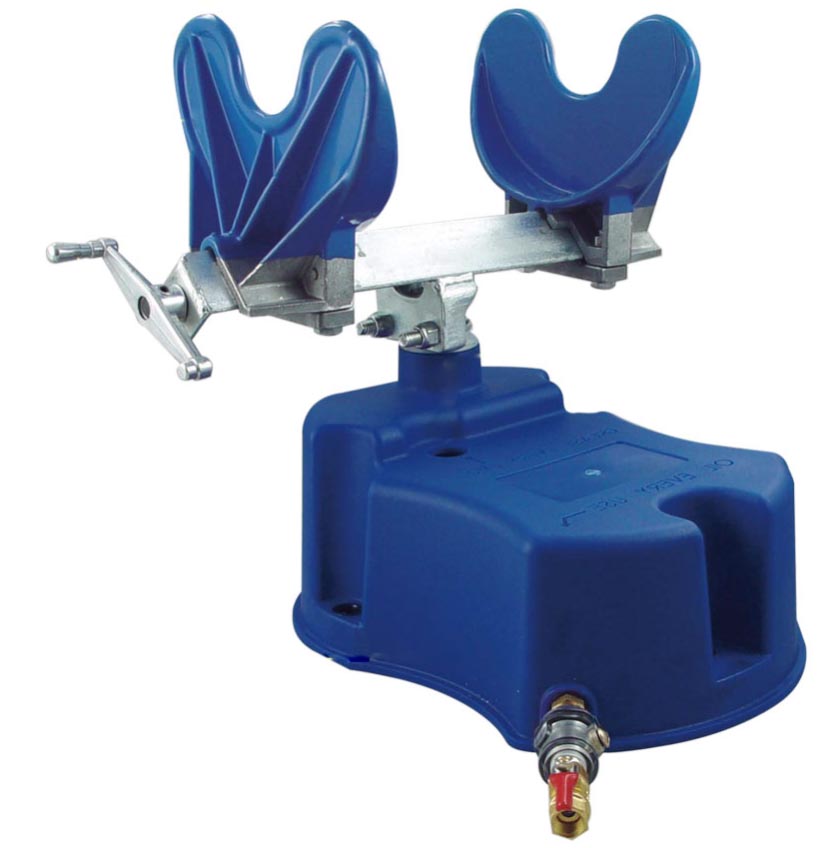A paint shaker is a device specifically designed to mix paint. It uses mechanical vibration or shaking to evenly distribute pigments, solvents, and other components in the paint, preventing sedimentation and layering, and ensuring consistent and stable coating results. The primary function of a paint shaker is to use mechanical force to quickly and thoroughly disperse settled pigments and mix them with other components within just a few seconds to a couple of minutes, ensuring that every can of paint achieves optimal performance. Below is a detailed analysis of its core features and application scenarios:
1. Mixing Mechanism
The paint shaker machine generates a vortex effect through high-frequency vibration or orbital motion, causing the paint to flow in wave-like patterns within the container. This breaks up the aggregation of pigment particles and eliminates hardened deposits at the bottom.
2. Types and Design
Shaking Type: Utilizes high-speed vertical and horizontal vibration mixing, making it suitable for low- to medium-viscosity paints, such as latex paint and water-based paints.
Rotating Type: Combines orbital and rotational motion to utilize centrifugal force for high-viscosity materials like oil-based paints and adhesives.
Multi-Arm Structure: Dual-axis mixers can process two containers simultaneously, achieving efficient homogenization through dual-axis rotation, particularly suitable for industrial-scale batch production.
Commercial and Industrial Fields
Paint Retail: Hardware stores use large shakers to quickly mix custom paint colors, ensuring consistency in every can.
Automotive Repair: Mixing metallic paint or clear coat to avoid color differences or graininess during spraying.
Aerospace: Boeing’s process specifications explicitly require the use of paint shakers to mix conductive coatings, ensuring uniform coating thickness and compliance with anti-static standards.

DIY and Home Users
Small portable shakers support various containers from pints to gallons, enabling on-site paint mixing and eliminating the need to travel back and forth to the store.
Experimental Applications: Some users modify them for mixing beverages or laboratory samples, demonstrating their versatility.

Special Scenarios
High-viscosity materials: Dual-axis mixers overcome material resistance through centrifugal force, making them suitable for viscous substances like construction coatings and putty.
Sensitive environments: Enclosed shakers prevent volatile organic compound (VOC) leaks, meeting environmental requirements and commonly used in chemical or pharmaceutical industries.
Usage Guidelines
Ensure that the container is sealed and leak-free to prevent paint splatter or motor damage.
The equipment must be grounded and placed on a stable surface to prevent overturning due to vibration.
Avoid using non-explosion-proof models in flammable environments. When using solvent-based paints, select a dedicated model.
Maintenance Recommendations
Regularly inspect wear-prone components such as springs and power cords. Worn springs must be replaced as a set to maintain balance.
Promptly clean up any spilled paint to prevent clumping that may affect vibration performance.
Mixing Time Control
Most shakers are equipped with a 15-minute timer, but the actual mixing time should be adjusted based on the condition of the paint.
1. Shaking Type Paint Shaker
Principle: High-frequency vertical and horizontal reciprocating vibrations create wave-like flow within the container, breaking up settled particles.
Features: High vibration frequency, moderate mixing force, suitable for low to medium viscosity coatings.
Application Scenarios: Commercial hardware stores, automotive repair shops; home-use small models can handle paint in pint-sized containers.
Representative Models: Single-arm shaking-type shakers commonly found in hardware stores.
2. Rotating Type
Principle: Utilizes a combination of orbital and rotational motion to generate centrifugal force, causing the paint to spin at high speeds and forcefully disperse high-viscosity particles.
Features: Strong mixing intensity, capable of handling high-viscosity materials, and preventing hard lumps left behind from manual stirring.
Application scenarios: Industrial production, automotive original equipment manufacturing (OEM) painting lines.
Subtypes:
Planetary rotation: The container orbits around the central axis while rotating on its own axis, resulting in more uniform mixing.
Drum rotation: Similar to a drum washing machine, suitable for batch mixing in sealed containers.
3. Vortex Mixing Type
Principle: High-speed vortex oscillation creates a vortex at the bottom of the container, rapidly dispersing small quantities of paint.
Features: Compact size, extremely high speed, but only suitable for small volumes.
Application scenarios: Laboratory color matching, model paint, small bottle sample mixing.
1. Industrial-grade large shaker
Capacity: 10-200 gallons, supports forklift loading and unloading.
Features: High-power motor, capable of continuous operation, some models equipped with automatic loading/unloading devices.
Applications: Mass production in paint factories, mixing thick coatings for construction projects.
2. Commercial-grade medium-sized shaker
Capacity: 1–5 gallons paint shaker, commonly found in hardware stores and building material markets.
Features: Semi-automatic operation, equipped with a 15-minute timer, compatible with standard paint cans.
Applications: Custom color paint mixing, pre-treatment for automotive touch-up paint.
3. Home/portable small paint can shaker
Capacity: 0.1–1 gallon, lightweight, portable.
Features: Plug-and-play, some models include suction cup mounting.
Applications: Home DIY painting, furniture renovation, and handcrafted model coloring.
1. Single-arm type
Structure: A single clamping arm secures the container, mixing one container at a time.
Features: Simple structure, low cost, suitable for small-batch needs .
2. Multi-arm type (dual-axis/quad-axis)
Structure: 2–4 symmetrical clamping arms, capable of mixing multiple containers simultaneously .
Features: Doubles efficiency, suitable for batch processing.
1. Explosion-Proof Type
Features: Motor and circuitry are explosion-proof treated to prevent sparks from igniting volatile gases from solvent-based paints.
Applications: Mixing oil-based paints, banana water, and other flammable coatings.
2. Closed-type shaker
Features: Equipped with a sealed chamber to collect VOCs during mixing and connect to an exhaust gas treatment system.
Applications: High environmental standards, such as pharmaceutical production areas or food-grade paint mixing.
3. Smart programmable type
Features: Equipped with a touchscreen to pre-set mixing time and speed, with some models supporting data logging.
Applications: Precision coating and standardized mixing processes in laboratories.
Both the fully automatic electric paint shaker and the fully automatic paint mixer aim to achieve uniform mixing of paint or coatings. However, they differ fundamentally in terms of working principles, technical approaches, and applicable scenarios. These differences determine their distinct roles in modern automated production lines.
The most fundamental difference lies in the method of applying mixing force:
The core principle of the fully automatic Paint Shaker is “external inertial vibration.”
It uses a powerful motor to drive a mechanical system, generating high-speed, short-stroke reciprocating vibrations or shaking. A mechanical arm or conveyor belt system precisely positions and securely clamps the paint can onto the machine’s grippers, after which the entire can undergoes intense high-frequency movement along with the machine. Due to inertia, the different components inside the can undergo vigorous relative movement and impact, forcing them to mix uniformly in an extremely short time. Throughout the process, the machine only contacts the exterior of the can, never coming into contact with the material inside.
The core principle of the fully automatic acrylic paint mixer is “internal mechanical rotation.”
It typically features an automatically adjustable mixing head controlled by a robotic arm or gantry system. During operation, the system precisely locates the paint can’s position, then drives the mixing head downward, inserting its physical mixing paddle into the interior of the paint can. The motor drives the mixing paddle to rotate at high speed, directly applying shearing, compression, and agitation to the material via the paddle blades, creating intense vortices within the can to achieve mixing. Throughout the process, the machine’s core component—the mixing paddle—directly penetrates and contacts the material.
1. Mixing efficiency and speed:
The mixing process of a fully automatic agitator is extremely fast and powerful, typically completing the mixing of a can of paint within 30 to 90 seconds, including breaking up hard sediment blocks. Its cycle time is very short, and it has a huge throughput, like an “endless sprinter” on an assembly line.
Fully automatic mixers, however, require a relatively longer processing time, typically needing 2 to 5 minutes to achieve the same level of uniformity. Its speed is more significantly influenced by material viscosity and sedimentation levels.
2. Focus of Automation Integration:
Fully automatic vibrating mixers are typically highly integrated with linear or rotary conveyor systems. Its automation process focuses on container conveyance, positioning, clamping, and release, forming a high-speed, continuous assembly line operation.
The automation of fully automatic mixers, however, focuses more on the precise movement of the mixing head itself. It requires a system to precisely locate the center of the container, control the lifting and lowering of the mixing head, and most critically, must integrate an automatic cleaning station (CIP System).
3. Cleaning and cross-contamination risks:
Shakers have an absolute advantage in this regard. Since their mixing components never come into contact with the paint itself, they fundamentally eliminate the risk of cross-contamination. After processing a can of red paint, the next can of white paint can be processed immediately without any intermediate cleaning process.
Mixers, however, pose a potential cross-contamination risk because their mixing paddles penetrate the material. Therefore, after each mixing operation, the robotic arm must move the mixing head to a dedicated cleaning station, where the mixing paddles are automatically cleaned via high-pressure solvent rinsing and high-speed drying before the next operation can begin. This cleaning process occupies additional production time.
4. Applicability and container compatibility:
Shakers have higher requirements for container strength and standardization. Containers must be able to withstand intense vibrations without deformation or leakage, making them more suitable for standard metal cans. Different-sized cans may require adapter replacements.
Mixers offer greater adaptability to container materials and shapes. Whether using metal cans, plastic drums, or large-diameter cylindrical containers, as long as the mixing paddle can reach the bottom without contacting the container walls, mixing is possible. Mixers also have an advantage over agitators when handling extremely high-viscosity products, as mechanical shear force is more effective than inertial agitation for processing such thick materials.
Mixers offer greater adaptability to container materials and shapes. Whether using metal cans, plastic drums, or large-diameter cylindrical containers, as long as the mixing paddle can reach the bottom without contacting the container walls, mixing is possible. Mixers also have an advantage over agitators when handling extremely high-viscosity products, as mechanical shear force is more effective than inertial agitation for processing such thick materials.